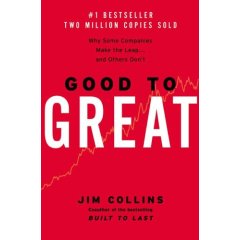
Good to Great: Why Some Companies Make the Leap… and Others Don’t
by Jim Collins
Collins and his team of researchers began their quest by sorting through a list of 1,435 companies, looking for those that made substantial improvements in their performance over time.
They finally settled on 11–including Fannie Mae, Gillette, Walgreens, and Wells Fargo–and discovered common traits that challenged many of the conventional notions of corporate success.
Making the transition from good to great doesn’t require a high-profile CEO, the latest technology, innovative change management, or even a fine-tuned business strategy. At the heart of those rare and truly great companies was a corporate culture that rigorously found and promoted disciplined people to think and act in a disciplined manner.
Peppered with dozens of stories and examples from the great and not so great, the book offers a well-reasoned road map to excellence that any organization would do well to consider.
Like Built to Last, Good to Great is one of those books that managers and CEOs will be reading and rereading for years to come. –Harry C. Edwards
From Publishers Weekly
After establishing a definition of a good-to-great transition that involves a 10-year fallow period followed by 15 years of increased profits, Collins’s crew combed through every company that has made the Fortune 500 (approximately 1,400) and found 11 that met their criteria, including Walgreens, Kimberly Clark and Circuit City.
At the heart of the findings about these companies’ stellar successes is what Collins calls the Hedgehog Concept, a product or service that leads a company to outshine all worldwide competitors, that drives a company’s economic engine and that a company is passionate about.
While the companies that achieved greatness were all in different industries, each engaged in versions of Collins’s strategies. While some of the overall findings are counterintuitive (e.g., the most effective leaders are humble and strong-willed rather than outgoing), many of Collins’s perspectives on running a business are amazingly simple and commonsense.
This is not to suggest, however, that executives at all levels wouldn’t benefit from reading this book; after all, only 11 companies managed to figure out how to change their B grade to an A on their own.





No comments:
Post a Comment